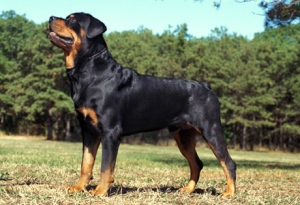The Rottweiler has a muscular, massive, powerful body. The head is broad with a rounded forehead. The muzzle is well developed. The teeth meet in a scissors bite. The wide nose is black. The lips are black and the inside of the mouth is dark. The medium-sized eyes are dark and almond shaped. Some Rottweilers have been known to have blue eyes or one blue and one brown eye. This trait is not recognized in the show world and does not meet the breed’s written standard. The ears are triangular and carried forward. The tail is customarily docked. Note: docking tails is illegal in most parts of Europe. Rear dewclaws are often removed. The chest is broad and deep. The coat is short, hard and thick. It is black with rust to mahogany markings on the cheeks, muzzle, paws and legs. A red color with brown markings also exists. There is a deficiency in the hair gene that makes the coloring a lighter red.To see more about rottweiler u can reach to (http://h.fanapp.mobi/rottweiler1)
German Rottweiler vs. American Rottweiler: some claim there are variations of Rotties, the German Rottweiler and the American Rottweiler. German Rotties are said to be shorter, stockier and have a bigger, blockier head, while American Rotties are said to be taller and leggier without as blocky a head. Others claim a Rottweiler is a Rottweiler and there is no such thing as a German Rottie. Some who have stated this argument have said, “A German Rottweiler is one born in Germany and an American Rottweiler is born in America.” In any case, there are breeders breeding for the German Rottweiler look of larger and blockier, while others are breeding for the American Rottweiler look, less blocky.

